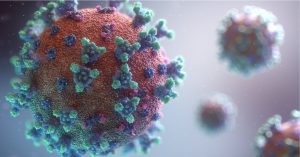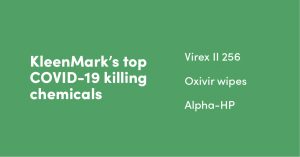Commercial cleaning companies, including those describing themselves as a “coronavirus cleaning service” use a variety of chemicals in their daily efforts to keep facilities disinfected. Given the pandemic, it’s likely you and your employees have a greater interest in understanding just what they’re using to kill COVID-19.

First and foremost, it’s important to understand what a disinfectant is. A disinfectant can be any EPA-approved chemical that has a 99.9% kill rate, meaning any bacteria or viruses it comes in contact with will die. Disinfectants are generally stronger than basic-cleaning products and require proper training to be used effectively and safely.

“We always want to use the eco-friendliest products possible,” said Mike Staver, KleenMark’s director of operations. “When fighting germs, though, we often use high-powered disinfectants that meet stringent standards. When used properly they create a clean and safe environment for your employees, customers and clients.”
Disinfectant essentials
KleenMark experts always look for three specifics things when selecting which disinfectants to use. It’s important that no matter what you or your Coronavirus cleaning service uses that you ID and understand the significance of each point listed below. Disinfectants our teams trust can be found, here.
- EPA approved – Never use anything the Environmental Protection Agency hasn’t approved. This federal blessing ensures that the chemical has been thoroughly tested and research and that the safety and usage guidelines are accurate. Check out List N to see disinfectants for use against COVID-19.
- Kills COVID-19 – This may sound obvious but every chemical should have a label listing what it kills – that includes COVID-19.
- Dwell time – Each disinfectant has a different dwell time, ranging from 1-10 minutes. What’s that mean to you? This tells you how long the chemical needs to remain on the surface you’re disinfecting and for how long that surface needs to remain saturated with the disinfectant.
To understand how to use disinfectants, check out this article.
“With dwell time, you may want a very short timeframe for disinfecting doorknobs and other surfaces cleaned multiple times each day,” Staver said. “In other instances, you may use a stronger chemical with longer dwell times, especially when doing a deep disinfecting after a positive COVID-19 case is confirmed in your facility.”
The chemicals KleenMark’s coronavirus cleaning service uses

So, what types of chemicals are commercial coronavirus cleaning services using? While varieties exist, KleenMark has established several disinfectants as their go-to weapons against COVID-19. All are EPA approved and have proven track records of success.
“Each chemical we use is thoroughly vetted and tested,” Staver said. “If we’re using it, I can guarantee it’s been put through rigorous trials and is the best option available.”
Virex II 256
- What it is: A one-step quaternary-based disinfectant cleaner that provides broad-spectrum disinfection.
- How/when we use it: Used to clean and prevent cross-contamination. This primarily is used for deep disinfection.
- What it does: Kills bacteria, viruses (including COVID-19) and fungus. Meets bloodborne pathogen standards for killing germs and viruses in blood and body fluids
Oxivir wipes
- What they are: Wipes formulated to deliver broad-spectrum disinfection in one minute or less.
- How/when we use it: Often used for high-touchpoint surfaces (doorknobs, light switches) that require frequent cleaning on a daily basis.
- What it does: This multi-surface cleaner/disinfectant kills most bacteria and viruses, including COVID-19
Alpha-HP
- What it is: An excellent multi-surface disinfectant that’s safe for the environment.
- How/when we use it: Used for daily cleaning and disinfection needs such as also be used on touchpoints and hard-surface sanitizing/disinfecting, except glass because it can leave a residue. It’s also used when we are responding to a confirmed COVID-19 case that requires deep disinfection.
- What it does: Kills bacteria and viruses (including COVID-19), and is a non-food contact sanitizer.
